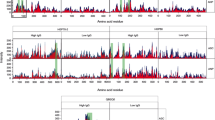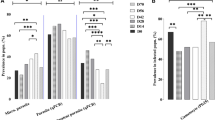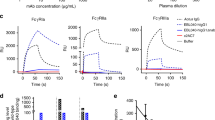Abstract
The feasibility of a malaria vaccine is supported by the fact that children in endemic areas develop naturally acquired immunity to disease. Development of disease immunity is characterized by a decrease in the frequency and severity of disease episodes over several years despite almost continuous infection1, suggesting that immunity may develop through the acquisition of a repertoire of specific, protective antibodies directed against polymorphic target antigens1–3. Plasmodium falciparum erythro-cyte membrane protein 1 (PfEMPI) is a potentially important family of target antigens, because these proteins are inserted into the red cell surface and are prominently exposed4–6 and because they are highly polymorphic and undergo clonal antigenic variation7,8,18, a mechanism of immune evasion maintained by a large family of var genes9–11. In a large prospective study of Kenyan children, we have used the fact that anti-PfEMP1 antibodies agglutinate infected erythrocytes in a variant-specific manner10,12–16, to show that the PfEMPI variants expressed during episodes of clinical malaria were less likely to be recognized by the corresponding child's own preexisting antibody response than by that of children of the same age from the same community. In contrast, a heterologous parasite isolate was just as likely to be recognized. The apparent selective pressure exerted by established anti-PfEMPl antibodies on infecting parasites supports the idea that such responses provide variant-specific protection against disease.
This is a preview of subscription content, access via your institution
Access options
Subscribe to this journal
Receive 12 print issues and online access
$209.00 per year
only $17.42 per issue
Buy this article
- Purchase on Springer Link
- Instant access to full article PDF
Prices may be subject to local taxes which are calculated during checkout
Similar content being viewed by others
References
Marsh, K. Malaria-a neglected disease? Parasitology 104, S53–S69 (1992).
Gupta, S., Trenholme, K., Anderson, R.M. & Day, K.P. Antigenic diversity and the transmission dynamics of Plasmodium falciparum. Science 263, 961–963 (1993).
Molineatix, L. Plasmodium falciparum malaria: Some epidemiological implications of parasite and host diversity. Ann. Trop. Med. Parasitol. 90, 379–393 (1996).
Magowan, C., Wollish, C.W., Anderson, L., Leech, J. Cytoadherence by Plasmodium falciparum-infected erythrocytes is correlated with the expression of a family of variable proteins on infected erythrocytes. J. Exp. Med. 168, 1307–1320 (1988).
Baruch, D.I., Gormley, J.A., Ma, C., Howard, R.J. & Pasloske, B.L. Plasmodium falciparum erythrocyte membrane protein 1 is a parasitized erythrocyte receptor for adherence to CD36, thrombospondin, and intercellular adhesion molecule 1. Proc. Natl. Acad. Sci. USA 93, 3497–3502 (1996).
Gardner, J.P., Pinches, R.A., Roberts, D.J. & Newbold, C.I. Variant antigens and en-dothelial receptor adhesion in Plasmodium falciparum. Proc. Natl. Acad. Sci. USA 93, 3503–3508 (1996).
Biggs, B.-A. et al. Adherence of infected rthyocytes to venular endothelium selects for antigenic variants of plasmodium falciparum. J. Immunol. 149, 2047–2054 (1992).
Roberts, D.J., Biggs, B.-A., Brown, G. & Newbold, C.I. Protection, pathogenesis and phenotypic plasticity in Plasmodium falciparum malaria. Parasitol. Today 9, 281–286 (1993).
Baruch, D.I. et al. Cloning the P. falciparum gene encoding PfEMP1, a malarial variant antigen and adherence receptor on the surface of parasitized human erythrocytes. Cell 82, 77–87 (1995).
Smith, J.D. et al. Switches in expression of Plasmodium falciparum var genes correlate with changes in antigenic and cytoadherent phenotypes of infected erythrocytes. Cell 82, 101–110 (1995).
Su, X. et al. The large diverse gene family var encodes proteins involved in cytoadherence and antigenic variation of plasmodium falciparum-infected erythocytes. Cell 82, 89–100 (1995).
Marsh, K. & Howard, R.J. Antigens induced on erythrocytes by P. falciparum: Expression of diverse and conserved determinants. Science 231, 150–153 (1986).
Forsyth, K.P. et al. Diversity of antigens expressed on the surface of erythocytes infected with mature Plasmodium falciparum parasites in Papua New Guinea. 41, 259–265 (1989).
Newbold, C.I., Pinches, R., Roberts, D.J. & Marsh, K. Plasmodium falciparum: The human agglutinating antibody response to the infected red cell surface is predominantly variant specific. Exp. Parasitol. 75, 281–292 (1992).
Iqbal, J., Perlmann, P. & Berzins, K. Serological diversity of antigens expressed on the surface of erythrocytes infected with Plasmodium falciparum. Trans. R. Soc. Trop. Med. Hyg. 87, 583–588 (1993).
Reeder, J.C. et al. Diversity of agglutinating phenotype, cytoadherence, and rosette-forming characteristics of Plasmodium falciparum isolates from Papua New Guinean children. Am. J. Trop. Med. Hyg. 51, 45–55 (1994).
Marsh, K., Otoo, L., Hayes, R.J., Carson, D.C. & Greenwood, B.M. Antibodies to blood stage antigens of Plasmodium falciparum in rural Gambians and their relation to protection against infection. Trans. R. Soc. Trop. Med. Hyg. 83, 293–303 (1989).
Roberts, D.J. et al. Rapid switching to multiple antigenic and adhesive phenotypes in malaria. Nature 357, 689–692 (1992).
Anita, R., Nowak, M.A. & Anderson, R.M. Antigenic variation and the within-host dynamics of parasites. Proc. Natl. Acad. Sci. USA 93, 985–989 (1996).
Snow, R.W. et al. Periodicity and space-time clustering of severe childhood malaria on the coast of Kenya. Trans. R. Soc. Trop. Med. Hyg. 87 386–390 (1993).
Mbogo, C.N.M. et al. Low-level Plasmodium falciparum transmission and the incidence of severe malaria infections on the Kenyan coast. Am. J. Trop. Med. Hyg. 49, 245–253 (1993).
Trager, W. & Jensen, J.B. Human malaria parasites in continuous culture. Science 193, 673–675 (1976).
Inselburg, J. & Banyal, H.S. Plasmodium falciparum: Synchronization of asexual development with aphidicolin, a DNA synthesis inhibitor. Exp. Parasitol. 57, 48–54 (1984).
Author information
Authors and Affiliations
Rights and permissions
About this article
Cite this article
Bull, P., Lowe, B., Kortok, M. et al. Parasite antigens on the infected red cell surface are targets for naturally acquired immunity to malaria. Nat Med 4, 358–360 (1998). https://doi.org/10.1038/nm0398-358
Received:
Accepted:
Issue Date:
DOI: https://doi.org/10.1038/nm0398-358
This article is cited by
-
ICAM-1-binding Plasmodium falciparum erythrocyte membrane protein 1 variants elicits opsonic-phagocytosis IgG responses in Beninese children
Scientific Reports (2022)
-
IgG acquisition against PfEMP1 PF11_0521 domain cassette DC13, DBLβ3_D4 domain, and peptides located within these constructs in children with cerebral malaria
Scientific Reports (2021)
-
Immunization with virus-like particles conjugated to CIDRα1 domain of Plasmodium falciparum erythrocyte membrane protein 1 induces inhibitory antibodies
Malaria Journal (2020)
-
High-efficiency enrichment enables identification of aptamers to circulating Plasmodium falciparum-infected erythrocytes
Scientific Reports (2020)
-
In vitro selection for adhesion of Plasmodium falciparum-infected erythrocytes to ABO antigens does not affect PfEMP1 and RIFIN expression
Scientific Reports (2020)



